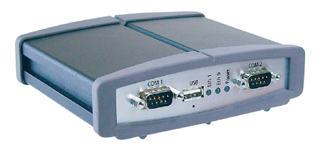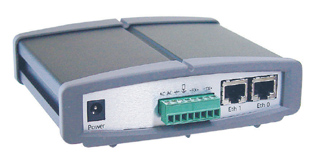Device profile: Botech Hubit — a web-based adapter for automation and control
Mar 20, 2003 — by LinuxDevices Staff — from the LinuxDevices Archive — viewsBotech's “Hubit” is a small Linux-based “black box” type device that resides on the web and interfaces to various industrial field buses, allowing remote web-based supervision of building automation and industrial processes.
The Hubit's users are presented with real-time animated presentations of individual remote processes, viewed on any convenient computer having a Java-enabled web browser. Data is stored in a database within the device, enabling many possibilities for analysis and presentation of sensor readings, energy usage, etc.
In addition to displaying data, the Hubit allows altering parameters in the remote systems — in other words, it offers both reading and writing capabilities. Another function provided by the Hubit is an extensive alarm handling system, whereby it can send alarm messages by means of either email or SMS.
Compact system platform
“We can run the Hubit's software on just about anything with a reasonable amount of memory and processing power, but our preferred platform is a small off-the-shelf box from Axis Communications,” said Botech system architect John Bindby.


Front (above) and rear (below) of the Hubit enclosure
Specifications for the Axis system are . . .
- 100 MHz ETRAX RISC-based system-on-chip processor
- 16MB RAM
- 6MB FLASH (half reserved for user-specific data)
- 2 RS232 ports
- 1 RS485/422 port
- 1 USB port
- 1 10/100Mbps Ethernet port
- 1 10Mbps Ethernet port
Why Linux?
“Botech chose Linux for three main reasons — familiarity, support, and price,” explained Bindby. “We already had developers with experience, right from the start. The availability of support from the Linux community is unbeatable. And nothing beats free, right?”
“Axis provides a basic embedded Linux distribution with a GCC cross-compiler and a patched 2.4.19 kernel,” Bindby said. “The greatest drawback of this solution is that we can't use their distribution for any other platform, and we can't use our ordinary [Linux] distribution for their platform.”
“However, on the plus side, there wasn't really much modification that needs to be done, so the time to market was drastically reduced comparing to several other alternatives we've tried,” continued Bindby.
“One of the most challenging problems we encountered when porting our software to an embedded device was tha lack of an efficient, small, fast data storage utility — preferably one which would understand SQL syntax,” recalled Bindby. “So we had to make our own.”
The Hubit-specific software running on the system consists of roughly 200,000 lines of “more-or-less platform-independent C++ code,” Bindby added. “I've often heard statements to the effect that 'C++ has no place in embedded computing,' but I think this product proves otherwise!”
“We're really happy about our choice [of using embedded Linux] — and in retrospect, the development cycle of this product has proven us right again and again,” observed Bindby. “We do, however, acknowledge that Linux is not the only choice there is. The competition is fierce, but it seems safe to say that Linux will hold its place and even grow bigger in the field of embedded computing.”
About Botech
Botech (Malmo, Sweden) specializes in web-based software and systems for building automation, including products for process controlm, data acquisition, and energy management.
This article was originally published on LinuxDevices.com and has been donated to the open source community by QuinStreet Inc. Please visit LinuxToday.com for up-to-date news and articles about Linux and open source.